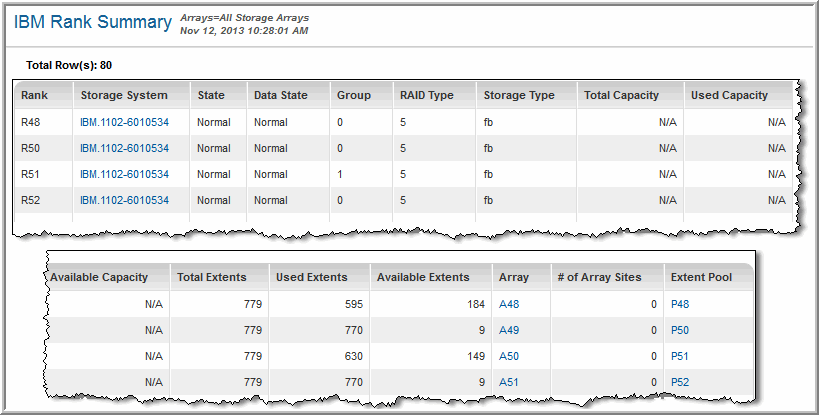IBM Rank Summary
Use Search to find a template, report or dashboard by name. Search is case insensitive, supports partial entries, and will display a list of potential matches.
As you enter the name in the Search field, up to 10 potential matches are displayed. If the template, report or dashboard is shown, you can select and run it directly from the match list. You can also click All Items in the match list to go directly to the Search Results.
StorageConsole provides different navigation options to slice and examine your collected data. You can explore the data by using the APTARE customizable report templates or by using parts of your IT infrastructure as entry points. The Inventory Navigator serves as a browser for your infrastructure by object type. See also
Exploring Your Inventory.
Use the Reports tab to examine the StorageConsole catalog of templates, dashboards and reports - organized by products along with user-created, and system folders. This report is located here:
Capacity Manager > Array Capacity & Utilization > IBM Rank Summary
An IBM Rank is logical storage, enabling storage provisioning that is not constrained by the size of an array. One or more arrays comprise an IBM Rank, forming logically contiguous storage. Note that IBM often refers to Arrays as RAID Arrays.
Understanding IBM Enterprise Storage Capacity Calculations
• Capacity values for IBM arrays may appear different from what is reported by the IBM CLI or IBM Tools, as IBM uses a decimal gigabyte—10^9 bytes, while StorageConsole uses 1024 for a KB when converting to GB.
• For FB open systems hosts, an extent is 1 GB. For CKD IBM zSeries or S/390 systems, an extent is 1 cylinder (.92 GB).
In the Scope Selector, you can narrow the report output by selecting values for the following criteria:
• State: Normal, Configuring, Unassigned, Reserved, Deconfiguring, Depopulating, Configuration Error, Deconfiguration Error
• RAID Types: 5, 6, 10
• Storage Types: fb, ckd
Rank | The name of the group of arrays |
Storage System | The physical storage system on which the rank resides |
State | The Configuration State: Normal, Configuring, Unassigned, Reserved, Deconfiguring, Depopulating, Configuration Error, Deconfiguration Error. A rank remains in an unassigned state until it is assigned to an Extent Pool. |
Data State | Normal - If no other data state issues, it is Normal. Note that an unassigned array will have a Normal data state. Degraded - A disk drive module in the array may be rebuilding. Read Only - Possible issues: one or more disk drive modules have failed; there aren’t enough spares available for rebuilding; data loss could occur if writes continue without redundancy. Failed - Possible causes: Two or more disk drive modules have failed; disk drive modules aren’t available for rebuilding data. Repairing - Array repair could be accepted, but not yet complete. Inaccessible - The storage image can’t access all the data on the array. |
Group | The Rank Group is either 0 or 1, corresponding to the Extent Pool ID. |
Raid Type | RAID 5, 6, or 10. |
Storage Type | Fixed block (FB) or Count-Key-Data (CKD). |
Total Capacity | The rank’s total capacity; the capacity is derived from the number of extents. |
Used Capacity | Amount of storage used by the rank. |
Available Capacity | Amount of the Rank storage that is available for use. |
Total Extents | The total number of Extents, striped across the disks in the array. |
Used Extents | The number of partitions/extents that are in use. |
Available Extents | The number of extents available for use. |
Array | The arrays that comprise the Rank. An Array (also known as a RAID Array) is an Array Site that has been formatted to a specific RAID format. |
# of Array Sites | 1 or more Array Sites comprise an Array, from which the Rank is configured |
Extent Pool Name | Links to the IBM Extent Pool Summary. |

